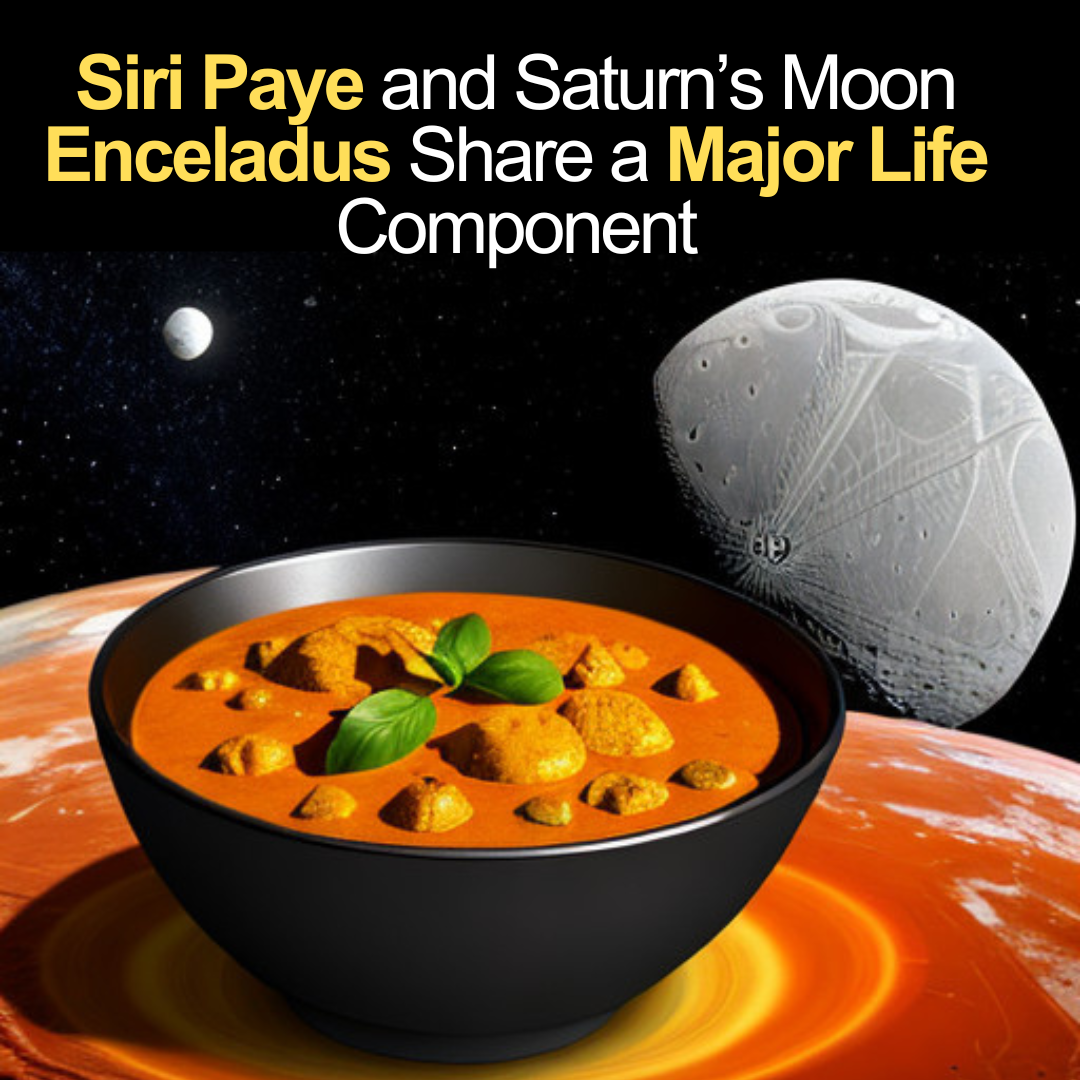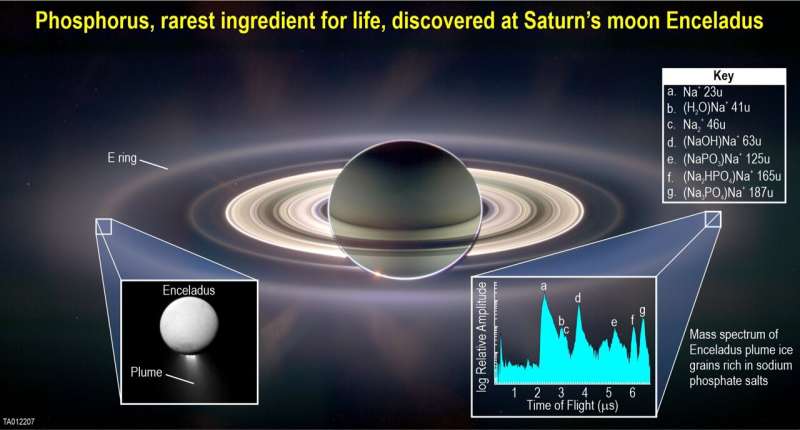The curiosity to solve the world’s mystery is essential for humans to understand themselves and find the purpose of their existence. An exciting way to do that is to search for life beyond Earth.
Saturn is the sixth planet in the distance from the Sun and the second-largest planet in our solar system; it is also well-known for its most spectacular rings. Just like the Earth, Saturn has its own set of moons orbiting around it, and one of such moons has grabbed the scientists’ attention as it could potentially host life!
The uncanny similarity of the existence of phosphorus in bone broths and water-spraying plumes of Enceladus is what is called a “chef’s kiss”.
Life on Enceladus
The building blocks of life and water are carbon, oxygen, nitrogen, hydrogen, phosphorus, and sulfur. Saturn’s icy ocean moon, Enceladus, is thought to have liquid water oceans beneath its frozen shell. Cassini spacecraft had collected and analyzed samples from this moon, which, after decades of research, proved to have the existence of organic material on Enceladus.
Enceladus sprays its ocean into space from plumes that the Casisinis Cosmic Dust Analyser sampled and detected. Scientists at NASA have determined that Enceladus has most of the chemical ingredients needed for life and likely has hydrothermal vents spewing hot, mineral-rich water into its ocean (Choblet et al., 2017).
The search for extraterrestrial life in our solar system became more exciting when a team of scientists, including Southwest Research Institute’s Dr Christopher Gleinin 2020 discovered new evidence that the subsurface ocean of Saturn’s moon Enceladus contains a fundamental building block for life. “Using data from NASA’s Cassini mission, the team directly detected phosphorus in the form of phosphates originating from the moon’s ice-covered global ocean.” (Postberg et al., 2023)(qtd.in SWRI)
Phosphorus — A key component of Life
Phosphorus is the second most abundant mineral in the body, second to calcium. About 85% of the body’s phosphorus is stored in the bones and teeth of humans and animals as phosphates and in their DNA, RNA and cell membranes (Avenue et al., 2022). It is also a vital component of food in nutrients and minerals. Phosphorus is globally consumed in a variety of foods like beef or legumes and dishes made of bone broths, such as Siri Paye across Pakistan and South Asia.
Siri paya is a traditional Pakistani stew made with the head and feet of an animal (typically goat, cow, or lamb), called Siri and paya in Urdu, respectively. It is a typical breakfast meal in the country. The bones are slow-cooked in boiling water with added spices for 4-6 hours. This bone broth is considered nutritious and is enjoyed in the winter among the Pakistani community (Siri et al.). When served with bone marrow, Siri Paye is called “Nalli Siri Paye”, the most delectable version of this dish.
What does Siri Paye have to do with Enceladus?
The revelation of understanding the connection between phosphorus in the human diet and the plumes of Enceladus helps bridge gaps in our understanding of the universe. Bone broth of a Chinese dish called ‘sweet-sour-spareribs’ is also cooked similarly to Siri Paye. A study was conducted by scientists at Oregon State College, Corvallis, to detect how much nutrition this Chinese dish can provide, such as calcium and phosphorus. (Hoh et al., 1934)
The presence of calcium and phosphorus was analyzed before and after cooking, which showed a generous presence of phosphorus at 0.384 gm (Hoh et al., 1934). Similarly, bone marrow is also enjoyed in a variety of dishes. Studies on the nutritional value of bone marrow suggest that “one tablespoon (14 grams) of raw caribou bone marrow provides 1% Phosphorus of the RDI.(Hassan et al., 2012).These studies help reveal its presence in our diets.
This uncanny similarity of the existence of phosphorus in bone broths and water-spraying plumes of Enceladus is what is called a “chef’s kiss”. Life on Earth is just as complex yet simple as we seek it in the universe to be. Such analogies between Earth and other habitable planets or moons can help us take steps further into Astrobiology.
Dr Glein is a leading expert in extraterrestrial oceanography; his team found that phosphate concentrations are at least 100 times higher in the moon’s plume-forming ocean waters than in Earth’s oceans” (qtd.in SWRI). They analyzed a class of salt-rich ice grains with Cassini’s Cosmic Dust Analyzer, which showed the presence of sodium phosphates. The team’s observational results and laboratory analogue experiments suggest that phosphorus is readily available in Enceladus’ ocean as phosphates (Postberg et al., 2023).
This breakthrough discovery for astrobiology can lead studies in the search for life beyond Earth. Glein believes “the next step is to return to Enceladus to see if the habitable ocean is actually inhabited”.(Postberg et al., 2023). If that is the case, Pakistani food enthusiasts must keep a keen eye on Enceladus to someday enjoy extra-terrestrial Siri Paye.
References:
- Avenue, 677 Huntington, Boston, & Ma 02115. (2022, March 2). Phosphorus. The Nutrition Source. https://www.hsph.harvard.edu/nutritionsource/phosphorus/
- Hassan, A. A., Sandanger, T. M., & Brustad, M. (2012). Level of selected nutrients in meat, liver, tallow and bone marrow from semi-domesticated reindeer (Rangifer t. Tarandus L.). International Journal of Circumpolar Health, 71, 10.3402/ijch.v71i0.17997. https://doi.org/10.3402/ijch.v71i0.17997
- Hoh, P.-W., Williams, J. C., & Pease, C. S. (1934). Possible Sources of Calcium and Phosphorus in the Chinese Diet: I. The Determination of Calcium and Phosphorus in a Typical Chinese Dish Containing Meat and Bone. The Journal of Nutrition, 7(5), 535–546. https://doi.org/10.1093/jn/7.5.535
- Institute, S. R. (n.d.). Key building block for life found at Saturn’s moon Enceladus. Retrieved 3 August 2023, from https://phys.org/news/2023-06-key-block-life-saturn-moon.html
- Postberg, F., Sekine, Y., Klenner, F., Glein, C. R., Zou, Z., Abel, B., Furuya, K., Hillier, J. K., Khawaja, N., Kempf, S., Noelle, L., Saito, T., Schmidt, J., Shibuya, T., Srama, R., & Tan, S. (2023). Detection of phosphates originating from Enceladus’s ocean. Nature, 618(7965), 7965. https://doi.org/10.1038/s41586-023-05987-9
- Siri Paye: The Breakfast Of Champions. (n.d.). Slurp. Retrieved 3 August 2023, from https://www.slurrp.com/article/siri-paye-the-breakfast-of-champions-1659549954356
- https://solarsystem.nasa.gov/planets/saturn/overview/
- https://solarsystem.nasa.gov/moons/saturn-moons/enceladus/in-depth/
- https://exoplanets.nasa.gov/search-for-life/why-we-search/
- https://ods.od.nih.gov/factsheets/Phosphorus-HealthProfessional/
- https://www.uppercrustindia.com/oldsite/11crust/eleven/feature11.htm
- https://www.slurrp.com/article/siri-paye-the-breakfast-of-champions-1659549954356
- https://jn.nutrition.org/article/S0022-3166(23)19470-3/pdf
- https://www.nationalgeographic.com/astrobiology/
- https://www.masala.tv/siri-paye-recipe/
- https://phys.org/news/2023-06-key-block-life-saturn-moon.html
- https://www.nature.com/articles/s41586-023-05987-9
- https://solarsystem.nasa.gov/news/13020/the-moon-with-the-plume/
- https://www.ncbi.nlm.nih.gov/pmc/articles/PMC4865312
- https://www.nationalgeographic.com/astrobiology/
- https://pubmed.ncbi.nlm.nih.gov/21031965/
Rebah Tanvir, a science communicator at Scientia Pakistan aims to empower young South Asian scientists with the tools needed to thrive in STEM fields. She advocates sustainability initiatives and has worked with not-for-profit organizations on SDG-driven projects to build a brighter future for her community. Rebah is a Biosciences graduate from COMSATS University Islamabad, Pakistan with research in Astrobiology. She’s currently associated with the World Space Week Association’s 2024 project on space and climate change.


